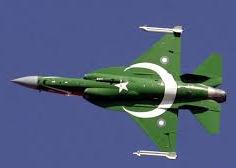During the Pakistan Prime Minister’s January state visit to Sri Lanka, Sri Lankan President Maithripala Sirisena and Prime Minister Nawaz Sharif are reported to have sealed a ‘landmark deal’ for the purchase of eight Pakistan-China built fighter planes. (Pakistan Aeronautical Complex/Chengdu Aircraft Industry Corporation (PAC/CAC) JF-17 Thunder combat aircraft).
This defence deal, would make Sri Lanka the first international customer of the fighter jet, although reports have also emerged that Nigeria will also buy three PAC/CAC JF-17 Thunder multirole fighters in 2016, based on information obtained by a Nigerian newspaper.
As of now, the there is no official confirmation of the deal, which might imply that a legal contract has yet to be signed. Pakistan has sought deeper defence ties with Sri Lanka for some time. “I conveyed our desire for more frequent port calls, participation in military exercises and defence seminars and training of military personnel,” Prime Minister Nawaz Sharif purportedly said while in Sri Lanka this week, according to Defense News.
In fact, Sri Lanka’s Minister of Defense, Karunasena Hettiarachchi, has denied that a deal was made. “The matter did not even come up for discussion during the talks [with the Pakistani government],” he said, according to the Colombo Gazette. Sri Lanka Ministry of Foreign Affairs spokesperson, Mahishini Colonne said that “if there arises a requirement for Sri Lanka to procure aircraft of this nature, in keeping with the policy of the Government of Sri Lanka to maintain transparency, expressions of interest will be called for, from all concerned.”
Sri Lanka’s inclination to buy Pakistan’s JF-17 fighter jets is fiercely opposed by India. New Delhi has been trying to sell its Tejas Light Combat Aircraft (LCA) to Sri Lanka. However, Sri Lankan military officials were hesitant and, among other things, allegedly pointed out that the Tejas LCA is not even in service yet with the Indian Air Force (IAF).
Indeed, only one fighter aircraft has been delivered to the Indian Air Force so far and the aircraft, developed by the Aeronautical Development Agency in cooperation with Hindustan Aeronautics Limited (HAL), only achieved initial operational clearance in December 2013.
Pakistani defense officials repeatedly announced over the past year that an unnamed Asian country has become the JF-17’s first customer. For example, during last year’s Dubai Air Show, Pakistan Aeronautical Complex officials revealed that an unidentified Asian country purportedly had signed an aircraft procurement contract, but failed to produce details.
Up until June 2015, Sri Lankan officials adamantly denied that a weapons deal with Islamabad has been signed. Back then, a Sri Lankan Air Force spokesperson said that “although both Pakistan and China have indicated the availability of the fighter jet and proposals have been submitted on the availability of the aircraft, SLA has not made any decision on purchasing them.”
The (PAC/CAC) JF-17 Thunder combat aircraft is manufactured at the Pakistan Aeronautical Complex (PAC) west of Islamabad, which has the capacity to produce 25 aircraft per year. Pakistan produces 58 percent of the airframe and China 42 percent respectively. Islamabad claims that the aircraft are assembled without any Chinese technical assistance.
However, reports say that Pakistan’s military aircraft industry appears unable to meet even domestic demand for the aircraft: Pakistan’s military ordered 110 additional JF-17 aircraft from China. So the question is whether Pakistan really has export capacity for the aircraft.
A number of air forces are currently considering acquiring the JF-17 from China, including Argentina, Bangladesh, Bulgaria, the Philippines, Venezuela, and Zimbabwe.

